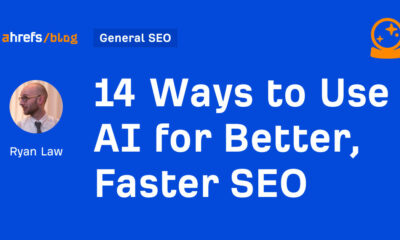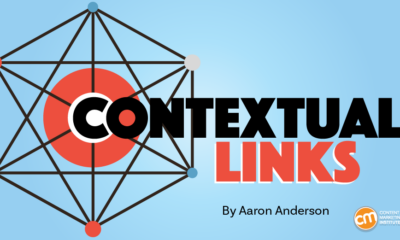PPC
18 AI Tools for Your Marketing Agency to Try in 2024

Efficiency is the key to running a profitable marketing agency. AI tools for marketing agencies help increase efficiency while maintaining—or increasing—the quantity and quality of work your team produces.
Those are all great outcomes. But with new AI tools sprouting like weeds, where do you start?
Here, you’ll find a brief overview of what AI tools can do for your marketing agency and a list of 18 AI tools to try. We’ve grouped the list by use case, so you can start with the ones that’ll have the greatest impact.
Table of contents
❓ Want to know what 300 agencies think about pricing, services, and challenges? Download our free State of the Digital Marketing Agency report.
What are the benefits of an AI tool for your marketing agency?
Every marketing agency can use AI to its advantage. Here are a few ways it can help yours.
Brainstorm ideas
AI writing tools and search engines can spark new ideas for your marketing content and campaigns.
Prompt an AI tool with questions like, “What are 20 B2B pain points companies face in the [input] industry?”. Or try, “Give me 50 campaign ideas to attract new customers in the [input] industry.”
While you have to verify accuracy and weigh different ideas, it’s a great starting point to get in a creative flow.
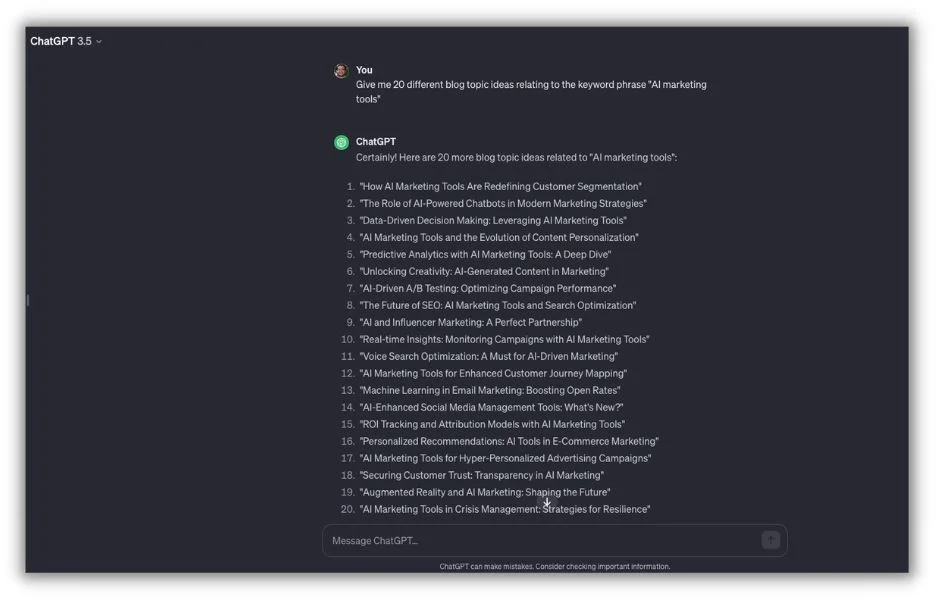
In this example, I type a question into ChatGPT, and it gives me 20 blog topic ideas to help brainstorm future articles.
Automate repetitive tasks
AI marketing agency tools help reduce predictable tasks. Whether hitting publish or transferring an inbound marketing piece to WordPress, you can save hours with efficient automation.
You can save precious hours you would have spent doing grunt work and instead use them to strengthen your marketing strategy and produce more materials.
Reach new markets
AI platforms can identify audience segments you hadn’t thought of before. You can also reach more markets by automating your process and easily repurposing different content mediums for new platforms.
Many opportunities exist to reach new markets with impressive research and content creation tools.
Reduce avoidable human error
Using the power of machine learning and AI, marketing AI tools can identify and correct errors before your clients see them.
A tool like Grammarly, for example, can correct grammar and spelling errors and improve phrasing automatically. AI is a great option that helps the marketing team be more productive while avoiding common issues.
Save on costs
Whether you need to save on production value with videos or crank out first drafts of social media content, there are plenty of areas where you can save time, labor, and money on daily marketing tasks.
That gives you and your team more time and energy to focus on the most essential, important tasks.
Now that we know the benefits of AI marketing agency tools, let’s review some of the best ones.
💡 Want more? Get your free guide to AI in marketing and see how you should and shouldn’t use this revolutionary technology.
Top AI tools for your marketing agency
Most AI marketing tools are built for a specific purpose, like writing new copy or automating a workflow. That’s how we’ve categorized this list, based on the primary challenge each tool tackles.
AI tools for content creation
AI copywriting tools have received the most spotlight in recent years. That’s helped fuel the creation of innovative generative AI tools with a growing list of useful features.
Since content isn’t all copy, we’ve included platforms that help you create and edit video and image assets, too.
1. ChatGPT
ChatGPT-3.5 and ChatGPT-4 (Open AI continues to create new versions) have led the AI writing craze by offering one of the most accessible copywriting tools.
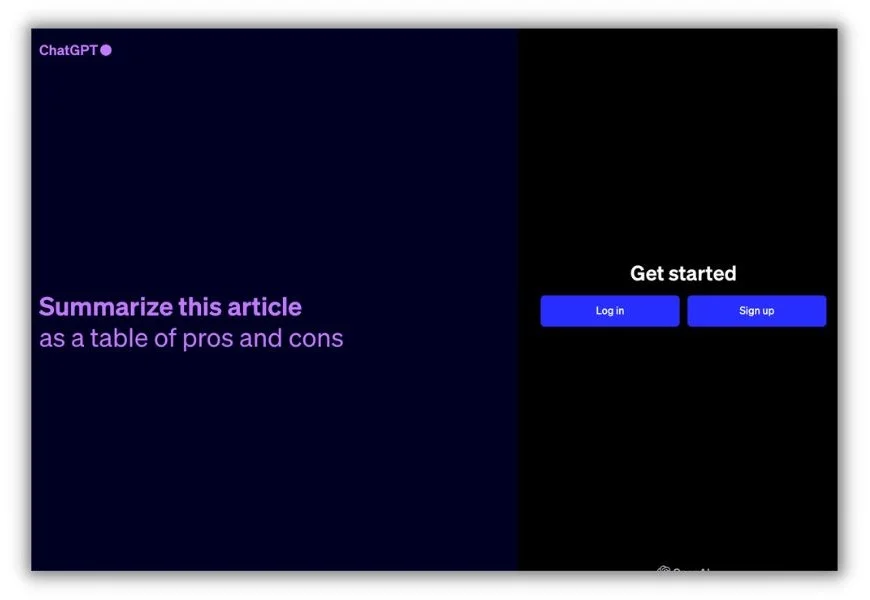

The platform is excellent for brainstorming. If you’re working on an email newsletter, social media campaign, or blog article, you can ask for ideas, outlines, lists, and many other starter materials to help you save time.
Some marketing agencies use it for content development, though there are risks in trusting its accuracy. Plus, the output often feels “AI-written.” But it’s a great trusty sidekick to get projects started and boost your marketing efforts.
Pricing: ChatGPT-3.5 is free to use, ChatGPT-4 starts at $20 per month.
2. Jasper
Jasper is another great AI writing solution built for teams and creative workflows.
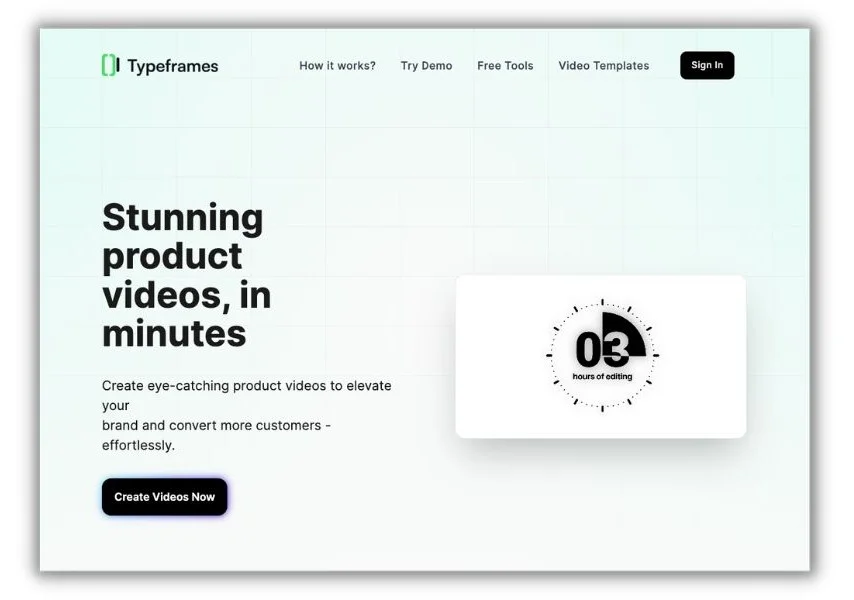

You can efficiently work with the platform for quick project creation and execution. The tool offers prompts and automates the “human” part of AI writing by incorporating your brand voice.
The tool also helps you write more factually (compared to ChatGPT) and on-brand.
Pricing: Plans start at $59 a month (billed annually).
3. Copy.ai
An alternative to Jasper, Copy.ai helps marketing teams automate blog briefs, create copy (like scraping URLs for AI ad copy), and accelerate other writing tasks.
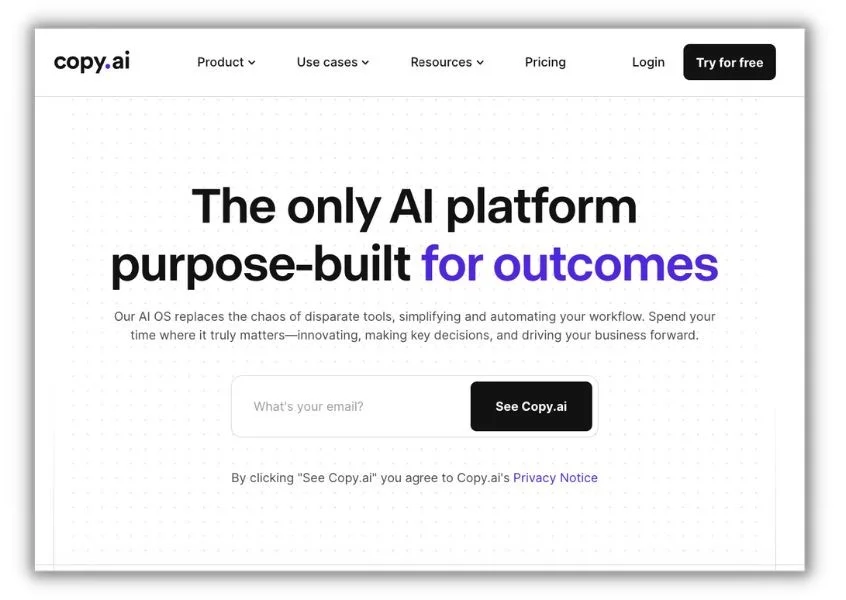

Copy.ai has many prompts and tools to help guide your writing queries for better results.
Pricing: Copy.ai is free to use with limited words. Upgrade to unlimited words for $36 monthly (annual plan).
4. Typeframes
This clever AI tool creates videos in just a few minutes. If you want to advertise a new product or create buzz for an event, Typeframes is the platform for you.


Easily type a few words, and the tool automatically makes a video. You can add music, animations, images, and other effects. It’s a great way to ship new ideas and campaigns with a fraction of the time and money you’ve spent in the past.
Pricing: Typeframes starts at $24 monthly (on the annual plan).
5. Midjourney
Midjourney is designed to make image creation easy.
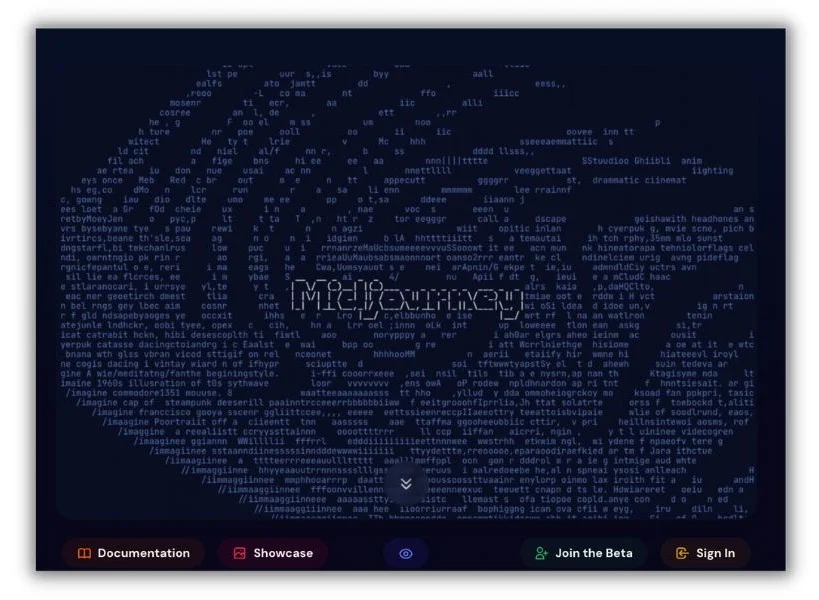

Using Midjourney, marketing agencies can make stunning, cinematic-style artwork that looks detailed and eye-catching. You can generate any style image in seconds. Whether it’s a realistic photo of customers enjoying your client’s offering with emotional benefits, a painting, or cartoon-style artwork, Midjourney will spin it up with a couple of prompts.
Midjourney can help save on specific stock photo needs or even give your design team a head start on a campaign.
Pricing: The platform starts at $8 monthly (billed annually).
6. Grammarly
Grammarly is an editing tool that spots and corrects your grammar and spelling errors. And its AI additions help you create content, too.
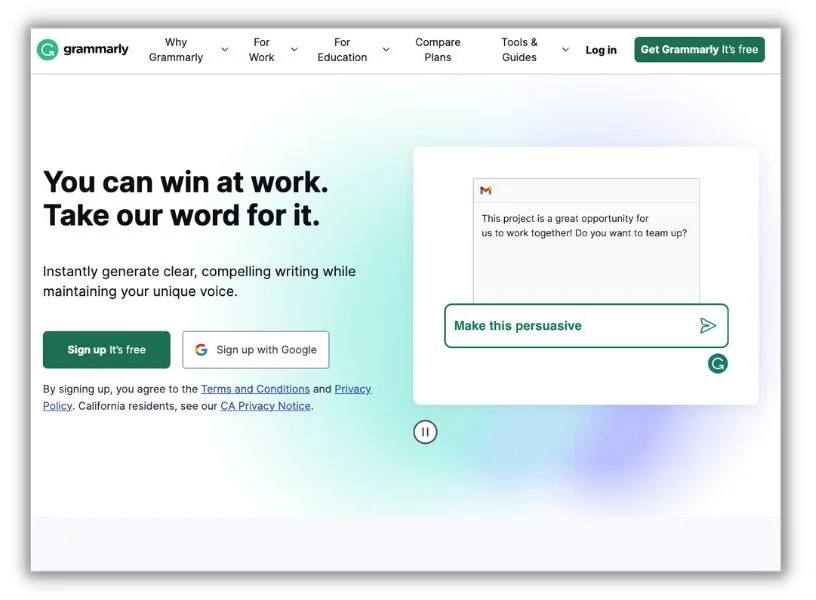

Use Grammarly to find awkward phrasings and passive sentences. It’ll also help you reword copy for a better read. The addition of generative AI gives Grammarly the power to suggest new ways to write existing text or help you start writing something completely new.
The platform is a must, and it will save you lots of time (and embarrassing moments like that one time you spelled “expresso” instead of “espresso”).
Pricing: Grammarly is free to use (with upgraded plans available).
AI tools for social media management
Social media is one of the fastest-moving components of marketing. Your clients need you to publish often, engage with their followers, and listen for trends and consumer needs. It’s not an easy job, so AI tools are pivotal to helping automatize and strengthen your agency’s strategy.
These tools automate repetitive social media marketing tasks so you can achieve greater returns for your clients.
7. FeedHive
FeedHive started as a scheduling and publication tool, but has since invested in powerful AI features to make social media content creation better and easier.
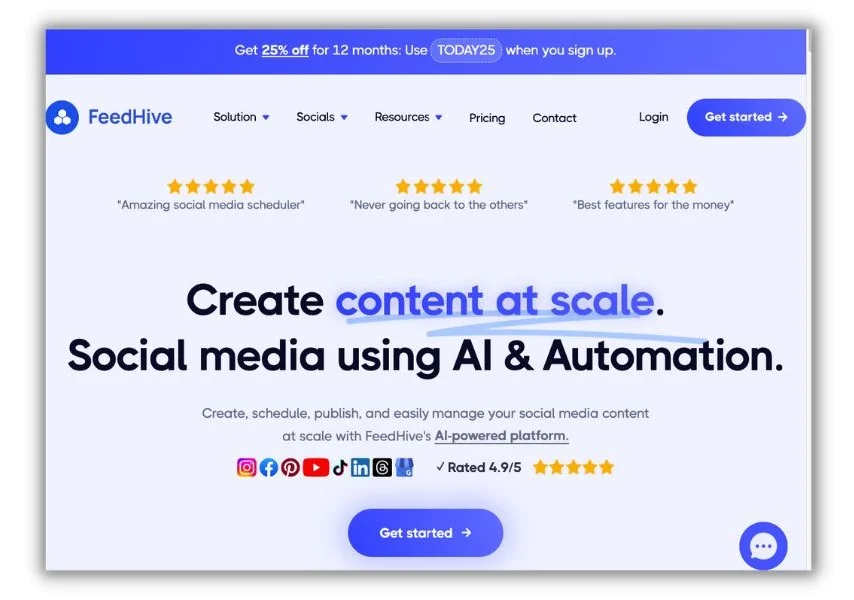

Now the platform helps you create new posts and get them published faster.
FeedHive’s AI collects analytics so you can get more information on your results. The platform also provides an AI chat assistant built on GPT technology. It helps with social media performance predictions and suggestions (like suggesting the best time to post).
Pricing: FeedHive offers an agency plan for multiple clients at $239 a month (billed annually).
8. Hootsuite OwlyWriter AI
Hootsuite is an early entrant in the social media management space, and it’s recently evolved to add AI capabilities.


For example, Hootsuite’s OwlyWriter AI is designed to quickly create captions and generate post ideas for all your accounts and segments. It’s a great way to utilize Hootsuite’s winning social media technology with a built-in writer—all in one place.
Pricing: OwlyWriter AI is free for a limited time to Hootsuite users.
9. Lately.ai
Lately.ai creates social media posts from your existing content.
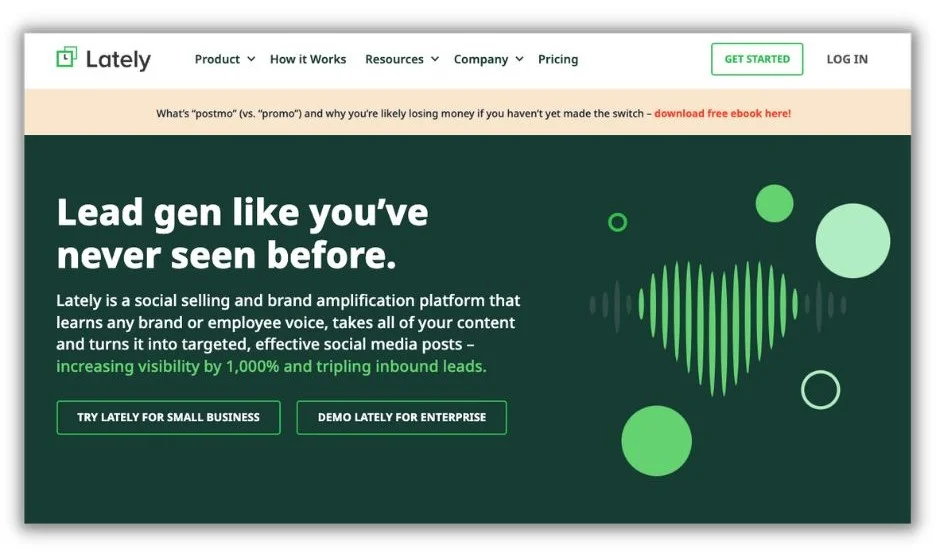

It’s hard to develop great social media content consistently. But what if I were to say you and your clients already have hundreds of social media posts hiding in the middle of all the other content you’ve created?
Lately.ai pulls all that dormant content from existing web pages, articles, documents, and ebooks. Then it uses AI to turn long-form assets into social media copy so you can publish more relevant and valuable posts with less effort.
Pricing: Lately.ai offers plans based on your number of social channels, with its first package starting at $49 monthly.
AI tools for automation
One of the best use cases for AI is streamlining operational tasks. Below are a few great platforms to improve key parts of your process.
10. Wordable
Transferring content from Google Docs to a CMS like WordPress can take thousands of hours and dollars. Between formatting posts and optimizing them for SEO, publishing content is a huge time sink. Wordable does it in one click.


The platform takes your Google Docs to WordPress, HubSpot, and Medium. It retains your format, headers, and HTML elements. The app saves you time, so you can focus on publishing more content.
Pricing: Wordable offers a limited plan for free. The paid plan is $50 a month.
11. Zapier
Zapier is a no-code solution that automates almost any repetitive task.
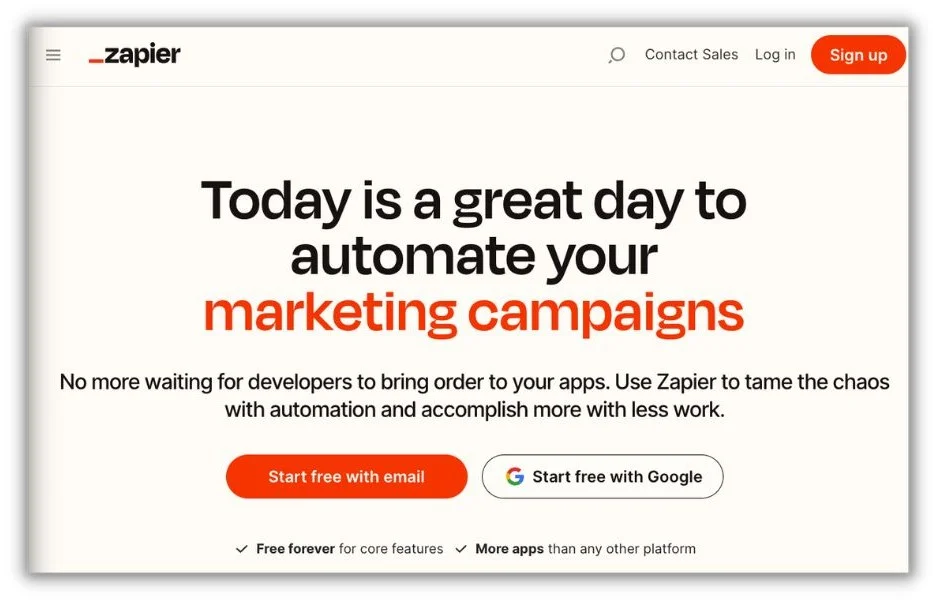

It works by connecting different platforms with APIs so they work together. If you start a new Word doc for each client project, then create an event in Asana, and generate a bill in an accounting tool, Zapier will link those platforms so it all happens as soon as you create the Word doc.
It’s a great platform for building your own AI solution as you face many predictable actions in your marketing agency.
Pricing: Zapier has a limited free plan with the option to upgrade, starting at $19.99 monthly (billed annually).
12. Taskade AI
If you need a great marketing project management tool, this might be for you. Taskade AI generates task lists and mind maps. It also helps you set up agendas and workflows—all with AI.
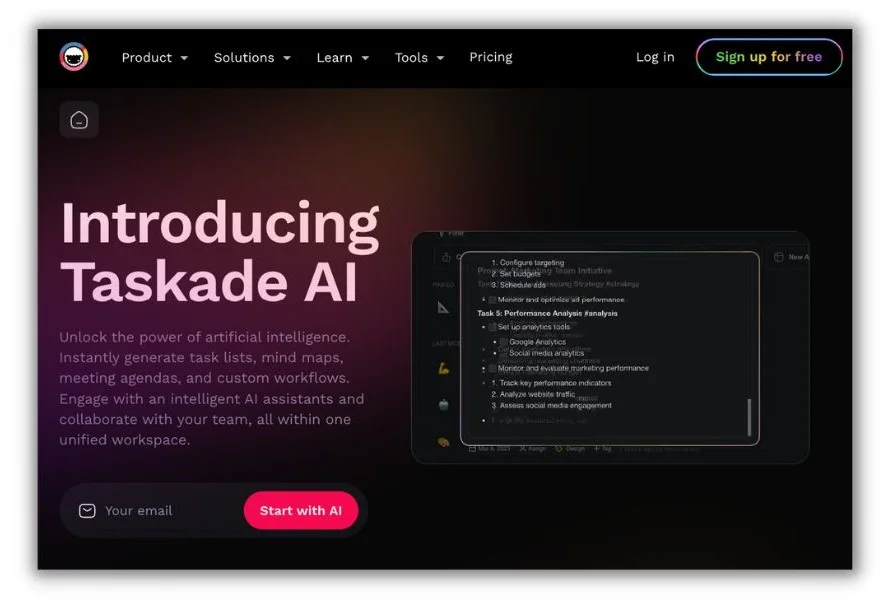

You can collaborate in your workplace and even utilize in-app AI assistance. It’s project management and strategy empowered by AI technology.
Pricing: The platform starts at $19 monthly (billed annually).
AI tools for chatbots
If you’re looking for a way to connect with clients on your agency website or onboard them for your app or portal, these AI solutions will help.
13. Drift
The Drift app is great for communicating with your clients and prospects 24/7. The B2B chatbot uses Drift technology called Conversational AI, which automates conversations.


The platform is designed to improve your sales pipeline to get more clients. The one downside is that it can be costly, but if it benefits your clients directly (or your agency), the revenue it generates might be worth it.
Pricing: Drift starts at $2,500 monthly.
14. HelpHub by CommandBar
HelpHub is another AI chat solution that learns from your resources, marketing website, content, and more to answer visitor queries on your agency website.


You can equip your clients and prospects with 24/7 assistance powered by AI technology and trained by your documentation.
Pricing: The starter plan is $249 monthly.
15. Perplexity
The Perplexity AI search platform is handy for content marketing research. You can get it as a browser extension and ask questions as you work on a piece.
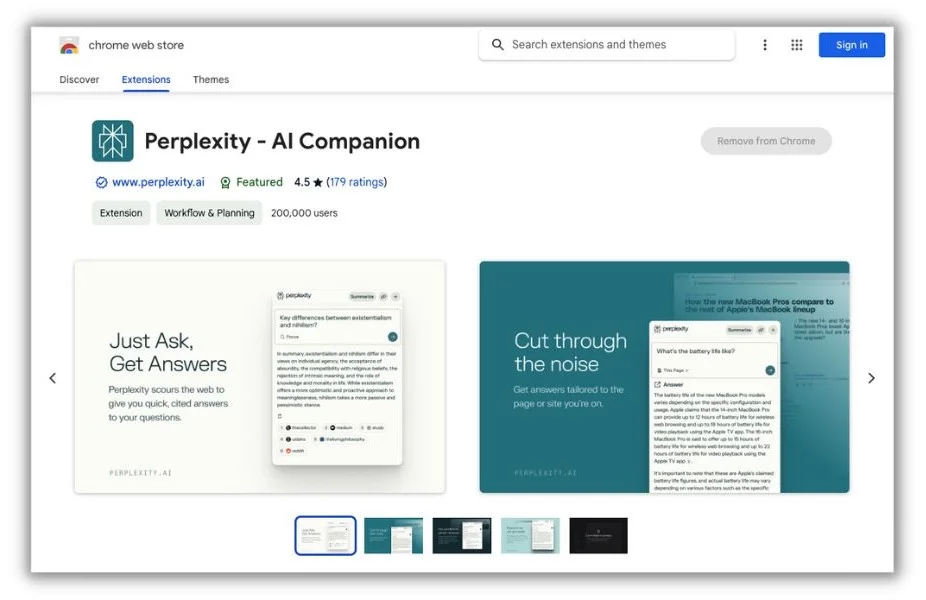

The bot answers you with multiple citations so you can verify the information, dig deeper, and link to sources if necessary (that’s a big win for AI writing!).
The app offers unique answers and resources that help you save time and escape a jam.
Price: Perplexity is free to use. Users can also upgrade to the Pro plan at $20 a month.
AI tools for SEO research
Research is the foundation of any successful SEO strategy. Here are the top tools you can use for your agency.
👋 Finding the perfect keywords is a snap with our free Keyword Tool.
16. Keyword Insights
Keyword Insights’ AI technology identifies thousands of keyword ideas, puts them into topic clusters, and helps you create content.
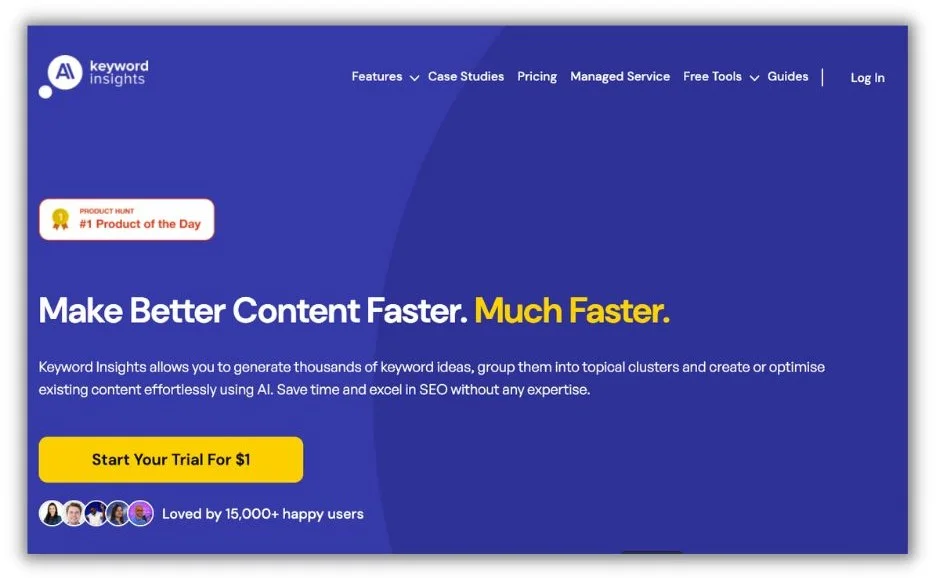

It’s a great automated tool for research, but it also helps you plan and outline your strategy. When you are ready to produce content, you click a button, and the information and brief go right to your content writer.
Pricing: The basic plan starts at $58 a month.
17. Clearscope
Clearscope uses AI technology to identify competing website pages and their common keywords, then analyzes your content for comparison. This can shave hours off the time you spend on each piece.


With Clearscope, you input your content and improve your chance of showing up on search engines by adding the suggested keywords and enhancing the piece using a graded scale.
Pricing: Plans start at $199 monthly.
18. Frase.io
Frase does a great job combining SEO research with AI writing. In short, you can do everything in one place to research, outline, write, and optimize your content.
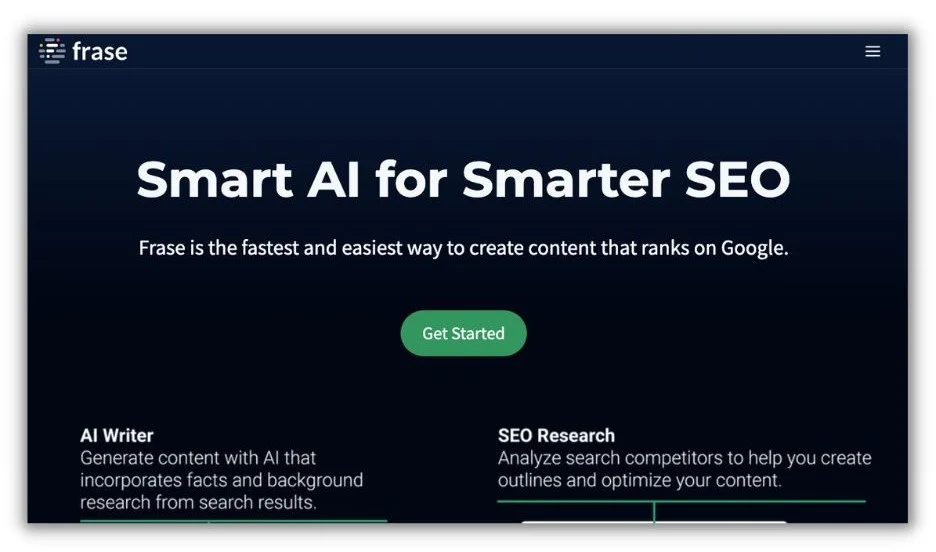

Pricing: Subscribers pay $12.66 monthly (billed annually) with options to upgrade packages.
Choosing the right AI marketing agency tools in 2024
Effective marketing AI tools help you save resources and increase productivity to build better campaigns and strategies. You just have to find the right fit.
It’s best to start with a challenge and work backward. Where are the workflow bottlenecks? What repetitive busywork is a creative contributor constantly bogged down by? Then, look for AI tools that address those challenges. Do that regularly, and you’ll run an even more efficient marketing agency.
Here are the best AI tools for marketing agencies:
- ChatGPT
- Jasper
- Copy.ai
- Typeframes
- Midjourney
- Grammarly
- FeeHive
- Hootsuite OwlyWriter AI
- Lately.ai
- Wordable
- Zapier
- Taskade AI
- Drift
- HelpHub
- Perplexity
- Keyword Insights
- Clearscope
- Frase.io
PPC
Google Ads Releases New Search Partner Insights & Controls Following Advertiser Concerns

One of Google Ad’s top benefits is its massive reach. Advertisers can easily reach billions of people across the greater web through Google search, Shopping, Maps, Gmail, YouTube, Discover, and more than 2 million different partner websites and apps. Google makes it easy for advertisers to reach all of these constantly updating placements across the web, too. Some of Google’s campaign types–such as Performance Max, App, and Smart campaigns–even automatically target all of these available placements to further simplify reaching this massive audience for advertisers.
However, seasoned advertisers know that not all placements are equally valuable. In fact, your brand’s ad next to the wrong content can upset your customers, damage your brand, and work against your goals. It’s crucial to monitor where your ads appear online to prevent these missteps, but for years, advertisers couldn’t view or control some of their ad placements on Google, specifically in their search partner network.
However, after some recent vocal concerns from brands, Google has responded and released a new tool for some advertisers to review their ad placements across the search partner network and exclude placements that may be inappropriate.
Contents
What is the Google Ads Search Partner network?
Believe it or not, Google isn’t the only search engine across the web! There are hundreds of smaller search engines and millions of websites with search bars–and many of them serve similar PPC ads within their search results. However, most of these smaller sites don’t build their own advertising platforms, such as Google Ads or Microsoft Advertising. Instead, they partner with Google (or Microsoft) to help advertisers connect with searches on their sites. These secondary search engines across the web make up the Search Partner network and collectively make up a decent share of search traffic for many industries.
🚨 Ready to learn how to maximize your campaign success across networks? Start with our free Google Ads Grader!
Google’s Search Network is comprised of two main components:
- Google search sites, which include Google Search, Google Shopping, Google Images, and Google Maps.
- Search Partner network includes YouTube search, smaller partner engines, and sites that host a search bar powered by Google. A surprising number of local and specialty websites are part of the Search Network–including some recognizable tertiary search engines like Ask.com.
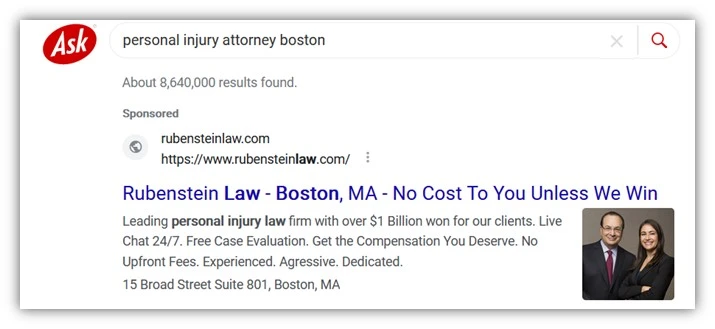
In Google Ads, advertisers can easily view their search campaigns’ results and segment their performance between Google search and the Search Partner network. Within search campaigns, advertisers can easily opt out of the Search Network at any time within their campaigns’ settings.


However, Google’s Performance Max campaigns don’t offer that visibility or flexibility to advertisers. Google’s Performance Max (and other fully automated campaign types) dynamically places your ads across the entire Google network (Google search, search partners, display, YouTube, video, discover, and Gmail) to dynamically use AI to maximize your campaign’s results.
The problems with Google’s Search Partner Network
Google’s Search Partner network’s additional reach is generally positive for advertisers–but that reach comes at additional costs and concerns. Even if most search partners on the network are from reputable, high-quality sites, the vast internet unfortunately hosts many low-quality sites and bad agents.
Google has never previously shared a list or directory of its ever-changing search partners. And unlike placements across the Google Display Network, advertisers haven’t been able to review where their ads appeared on the Search Network. Search advertisers had the choice to buy ads on the entire Search Partner network–or opt out entirely. Advertisers using Performance Max campaigns were automatically included across the entire Google network, including Search Partners.
Over the years, advertisers have become increasingly worried and vocal about the kinds of content their ads appeared alongside, and many advertisers have serious concerns about their brand image across the web.
Recently, Adalytics published a study revealing some concerning placements across the search partner network and discovered that several large companies, agencies, and government agencies were allegedly paying to show ads across some very questionable sites. Some of the examples from their study include pornographic content, pirated content, and sites that may be subject to international sanctions.
Google largely refuted the claims from Adalytics and assured advertisers that ad revenue wasn’t being shared with sanctioned entities. They further asserted that Adalytics claims were exaggerated and that such sites “represent a minuscule amount of [Google’s] Search Partner network.”
Shortly afterward, Google announced it would temporarily allow advertisers to opt out of the Search Partner network in Performance Max and App campaigns until March 1. Advertisers would have to contact Google directly to opt out of Search Partners in these campaigns.
Google’s new Performance Max campaign placement report
Addressing advertiser’s growing concerns, Google announced that it would begin to share more insights into where advertisers’ ads appeared across the web, including on the Search Partner network. Starting on March 4, advertisers can review how frequently their ads appeared across individual placements within their Performance Max and App campaigns.
The report is now available to all advertisers with active Performance Max and App campaigns. However, the reporting is slightly hidden from how advertisers generally review their search queries or other ad placements. Instead, advertisers can find these two new reports within the “report editor” section of the Google Ads dashboard.


The new Performance Max campaign placement report shows where and how often your Performance Max ads appeared on different placements from the web. Unfortunately, the report only shows the ad impressions from your Performance Max campaigns–other performance metrics, such as clicks, costs, and conversions, are unavailable.
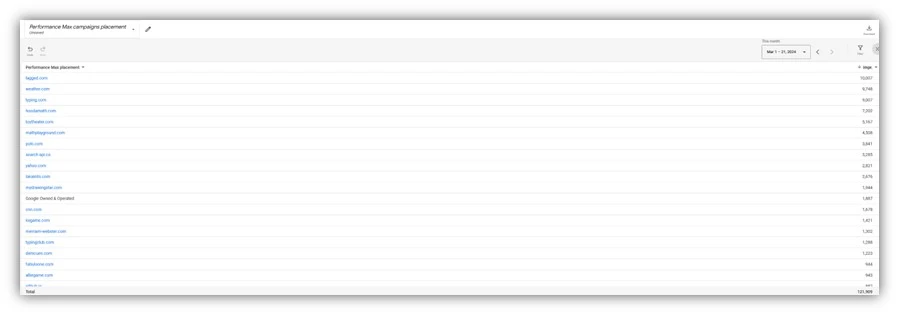

This reporting is only available for Performance Max and App campaigns. Traditional search and shopping campaigns still do not have any reporting available for individual placements across the search partner network.
🛠️ Set your Google Ads campaigns up for success with our free guide to the perfect Google Ads account structure!
How to opt out of Google search partner placements
Starting in March, Google will also allow advertisers to exclude individual Search Partner placements from showing ads for any campaigns in their account, including Performance Max. The placement exclusion can only be added at the account level–unlike many other placement exclusions, which are available at the campaign or ad group level.
To exclude a placement from showing your ads, you will need to create a placement exclusion list and apply it to your account. The Placement exclusion lists are kept under the “Tools and Settings” menu in Google Ads, under the “Shared Library.”
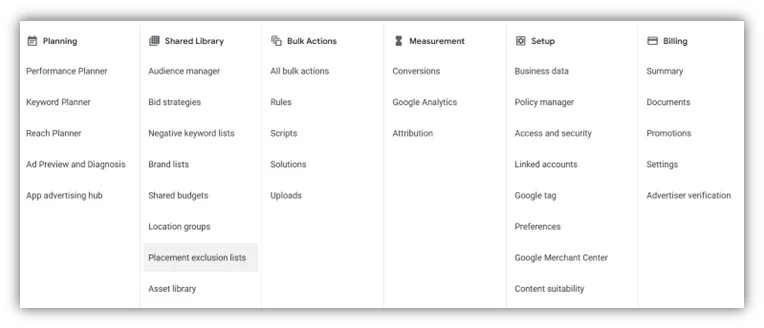

Once you create a new exclusion list, it will automatically be added to all of your campaigns in that account. New placement exclusions may take up to 12 hours to go into effect.
Take control over where your brand shows online
Google’s newest placement reports and exclusion options are designed to give advertisers more visibility into where their ads appear across the web and more control over their brand online. How much you decide to use these controls is up to you, but it’s always a best practice to review your placements and add new exclusions regularly.
Want more like this? How to Use Google’s New Brand Restrictions to Gain Back Control of Your Spend
PPC
5 Campaign Red Flags And Why They Matter

As PPC experts, we rarely have the luxury of harnessing 100% of our efforts and energy into a single account. When we do, it’s usually substantial, with multiple markets, products, and budgets to consider.
With a plethora of metrics to learn and utilize, optimizing our campaigns can feel overwhelming. Over the years, I’ve narrowed the optimization tasks down to focus on five key metrics and red flags. This will allow you to execute fast and effective boosts to campaign performance and efficiencies.
Here are 5 red flags to look out for on your PPC campaigns and, crucially, how to fix them.
1. A Weak Clickthrough Rate
We all know the importance of CTR (click-through rate) as a metric. It serves as a strong indicator of relevance between our keywords, our ads, and the user’s search terms. While the go-to benchmark used to be 2-3%, the introduction of automated bidding strategies and RSAs has moved this closer to 5-6% in most industries.
A CTR below this level raises considerable red flags. Not only does it indicate weak ad group relevancy, but it’s inefficient; the ‘Expected CTR’ of your ad has an effect on your ad rank, and bid, and will see you falling short at auction time.
Here are two simple, yet effective, fixes for a weak CTR:
Take your Assets Reports – a breakdown of the effectiveness of each headline and description – and start by swapping those ranked ‘Poor’ or ‘Average’ to new alternatives on your ads.
The second simple step is to review your ad groups. Over time, your ad groups and your keyword list are both likely to have expanded. Are there any opportunities to separate top-performing keywords from the rest? Do your keywords fit one neat theme, or are multiple themes creeping in? If so, separate them and tailor each ad’s copy to the new themes.
2. Missing or incomplete campaign settings
Back to basics. As someone who has audited 100s of accounts, time and time again I see the same handful of issues. By now, we’re all surely aware of the sneaky default location setting of ‘People interested in your targeted locations’ over ‘People in your targeted locations’. (If not, double-check your campaigns to ensure they’re serving where your target audience is!). There are, however, a few more settings worth checking on, and language settings are one of these.
On Google, language targeting matches queries “where the keywords match and Google believe that the user understands at least one targeted language”. On Microsoft Ads, the language campaign setting “determines the language that you will use when you write your ads and should be the language of your customers”.
Whether or not your brand has a global reach, your ad copy within each campaign is unlikely to be in all languages (often the default setting). When serving an international audience, best practice is to create unique campaigns and ad copy native to the respective local languages. Regional nuance is critical too.
Check your Campaign Settings to ensure that the language of your ad copy matches the audience(s) you’re asking your PPC platform to reach.
3. A lack of exclusions
If you’re running your accounts at peak efficiency, you should have plenty of exclusions in place. With the push towards upgrading your keywords to broad match, performance max black boxes, and a substantial rise in automation techniques, we PPC heroes need to be more on top of exclusions than previously.
Whether you’re running search, performance max, video, or display campaigns, exclusions are likely to apply to your campaigns.
Such exclusions include:
- Negative keywords
- Audience exclusions
- Content suitability, placement, or topic exclusions
- Brand exclusion lists
- Location or country-level exclusions.
If you don’t currently have exclusions applied to your campaigns, that could mean inefficient campaigns: targeting the wrong keywords, showing ads to current customer lists, on irrelevant or harmful content, on competitor content, or even in the wrong country entirely!
As a simple first step, begin by applying negative keywords to your account, campaigns, and/or ad groups and review your basic audience targeting options. If you can exclude current customers, reduce your demographic targeting from 18-65+, and double-check your campaign targeting and exclusion settings, that’s a great start.
4. Sub-par quality scores
One of the easiest ways to create inefficiencies is by failing to monitor quality scores. According to Google Ads, quality score is “a diagnostic tool meant to give you a sense of how well your ad quality compares to other advertisers”. This score is from 1-10, (1 being poor, 10 being excellent), is available at the keyword level, and is a product of the following three factors ranked from “below average” to “average” and “above average”.
- Expected CTR: Based on historical data, how likely is it that your ad will be clicked?
- Ad rank: How closely does your ad match the user’s search query and the intent behind it?
- Landing page experience: How useful is your landing page? Does it answer or support the user’s search query?
Luckily for those of us who struggle with math, the platforms calculate these for us based on the last 90 days of auction insights. In a perfect world, we’d aim for a quality score of 10 – although that may not always be possible. However, 7 or above is indicative of a ‘good’ quality score, with 3 or below being poor.
As with other items mentioned in this list, weak quality scores contribute to inefficient campaigns. To address this, work on optimizing each of the above three factors, starting with any that are ranked “below average”. Remember: the ultimate goal is to ensure that your keywords, ad copy, and landing pages are consistent in content.
5. No conversion data
And finally, one of the biggest red flags is a lack of conversion data. Generating zero conversions is one thing – and may be a red flag, but having no conversion data at all is concerning.
Today, PPC platforms are much stronger – particularly on brand-new accounts – on encouraging conversion setups before creating or publishing a campaign. However, there are plenty of legacy accounts with old, incomplete, or out-of-date conversion tracking, likely leading to millions of dollars in wasted spend annually. If you’ve been putting off the dreaded conversion tracking setup process, don’t delay further.
The final tip here is to ensure your conversion tracking is up to today’s standards. While conversion tracking for the end-goal of your campaigns is undeniably important, you’ll also want to track ‘lighter’ conversion events to give your PPC platform all the signals it needs to generate conversions – particularly when using smart bidding strategies.
If you’re using Maximize Conversions, Target CPA, Target ROAS, or Maximize Conversion Value smart bidding strategies and you have multiple conversion methods tracked (such as app downloads, phone calls, lead form fills, and product page views), ensure that each conversion is set up as a ‘Primary’ or ‘Secondary’ conversion goal respective to how important it is. Multiple primary conversion goals will make it difficult to optimize your campaigns.
Summary
Whether you’re brand new to PPC or have decades of experience, frequent platform changes often mean adapting what you thought you already knew! The five tips above should give you a great starting point for optimizing, improving, and boosting the efficiency and effectiveness of your accounts. Good luck!
PPC
86 Summer-Ready June Content Ideas

June marks the official start of summer, opening up many creative ways to connect with your audience. Throw in June’s holidays, summer solstice, and a bounty of food-themed days of appreciation (we’re looking at you, National Doughnut Day), and your June content calendar runneth over.
With all that fun in mind, we’ve gathered dozens of creative June content ideas. From entertaining videos to educational emails, you’ll find plenty of inspiration to fill this month’s content calendar.
Contents
💡 Want an entire year’s worth of marketing ideas? Download The Mega Must-Have Marketing Calendar.
June holiday content ideas
Although this month does not have any tentpole holidays like Thanksgiving or Christmas, there are several June holidays worth celebrating.
Father’s Day (June 16)
Great parents should be celebrated every day, but let’s face it, they’re often in the background doing the hard work most people don’t see. That’s why we celebrate Mother’s Day in May and Father’s Day in June, so these often unsung heroes get a little of the recognition they deserve.
If you want to get a gift for a dad with no strings attached, buy them a broken guitar (cue the groan). But seriously (sort of), Fire Department Coffee found a fun way to celebrate Father’s Day with an Instagram Reel full of dad jokes.
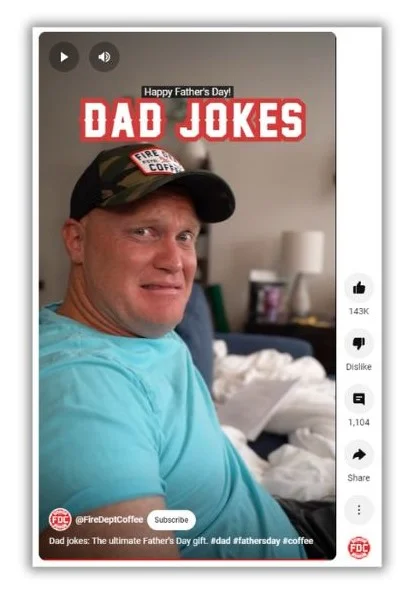
This is a low-lift way to have a little fun with your audience while keeping in the spirit of Dad’s big day.
Here’s another thing to be aware of. Father’s Day can be a difficult time for some people. If you’re running a Father’s Day email campaign, give your subscribers a way to opt out.
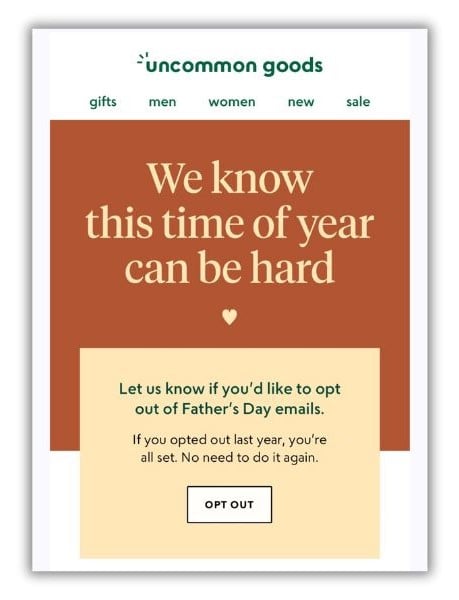

here are several other June content ideas geared toward dads and the people who care about them:
- Have a dad joke competition on social media.
- Get dads to comment describing their favorite way to spend Father’s Day.
- Write a blog post listing local Father’s Day discounts and events.
- Share a heartfelt shout-out to everyone who has lost their father, stepped in as a father figure, hopeful dads facing fertility issues, and fathers who have lost a child.
👋 Email is one of the best marketing channels available. Use The Complete Email Marketing Toolkit (Free Email Templates, Subject Lines, & Tips) to make the most of it.
Juneteenth (June 19)
On June 19, 1865—more than two years after President Lincoln signed the Emancipation Proclamation—Union troops arrived in Galveston Bay, Texas, the final holdout for the practice of slavery in the US. On that day, 250,000 enslaved Africans were finally granted their freedom. We now commemorate the history of that day as Juneteenth, often considered the second American Independence Day.
Juneteenth festivals are increasingly popular, with events popping up in big cities and small towns alike. The Brooklyn Mavens help their followers find the events by posting a video on Instagram with a roundup of what’s happening Juneteenth weekend.
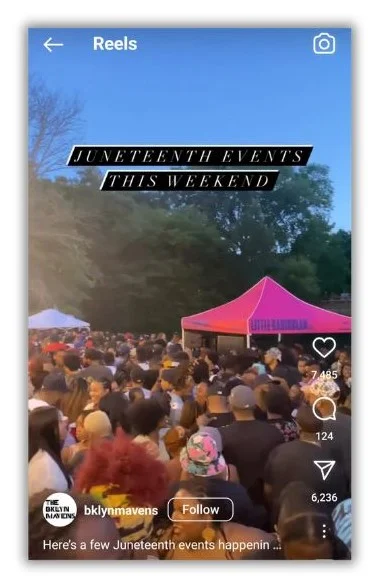

You can do the same on social media posts, blog posts, or even by email. But there are plenty of other ways to share in this important day. Here are a few ideas to get you started:
- Post powerful quotes from African American leaders.
- Write an article explaining the history of Juneteenth, covering what happened before and June 19th.
- Create a cooking video featuring Juneteenth-inspired recipes.
- Curate a list of books from Black authors or highlight the works of Black visual artists.
- Share a list of Black-owned businesses in your area.
Pre-Independence Day
For many people, the 4th of July is a big event that requires plenty of planning. That means you should share at least some of your Independence Day content ahead of time in late June.
ExtraSpace Storage shows us how it’s done with an extensive blog post full of ideas for a sparkling Fourth of July party.
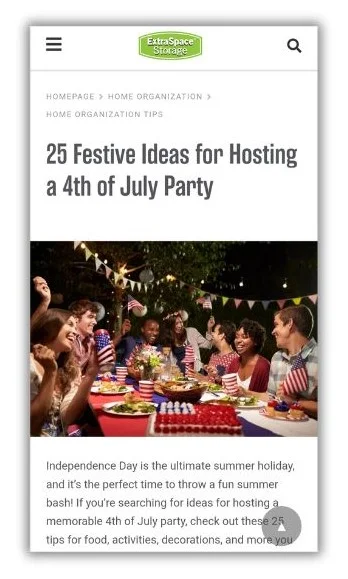

You can use the same strategy and create a big roundup of party planning ideas or go deep on one or two parts of planning a celebration, like these:
- Post a patriotic music playlist.
- Video a video showing how to clean and prep a gas grill.
- Make a shopping list of essentials for the perfect Independence Day party.
- Note local fireworks regulations and safety tips, plus mention that June is National PTSD Awareness Month as a way to remind people to be considerate with their fireworks displays.
June food content ideas
Sometimes, the fastest way to your followers’ hearts is through their stomachs. When it comes to planning your June marketing, don’t sleep on June’s variety of victual delights.
National Doughnut Day (June 7)
If you need to fill a hole in your June marketing calendar, celebrate one of the most beloved foods on the planet: the mighty doughnut! Just about anything you publish will garner good feelings (and maybe make your competition a little jelly).
The icing on top is that your brand doesn’t need to be a purveyor of cylindrical breakfast snacks at all. Take a look at this pastry-perfect post from Famer’s Almanac.


What’s brilliant about this tactic is the social media post directs viewers to a recipe on the Almanac’s website, offering a surgery slide into the business’s marketing funnel. Want to cash in on this confectionary? Try these Doughnut Day ideas for yourself:
- Get followers to vote on a March Madness-like bracket of the best doughnut toppings and fillings.
- Let people know where they can get discounts and specialty doughnuts around town.
- Create a slideshow of the most unusual, real-life doughnut recipes (like the hibiscus doughnut or the infamous cayenne pepper-topped Ring of Fire).
- Just share a picture of your staff enjoying their favorite doughnut.
National Corn on the Cob Day (June 11)
It may not have the draw of doughnuts, but no food signifies the start of summer like a fresh ear of corn on the cob. National Corn on the Cob Day, celebrated on June 11, is the perfect opportunity to engage anyone stalking your marketing channels.
This diabetes wellness account on Facebook has a cool take on hot corn. It shows you how to prepare corn on the cob without the extra calories and salt that come with traditional methods.


There are dozens of variations on the recipe that you can use. But don’t stop there. Mix in some more of these corny content ideas:
- Take a poll on Instagram asking how people eat their corn (with two-pronged cob holders, using the husk like a handle, or grabbing the ear with reckless abandon).
- Post some corn facts, like alternative uses for corn, the fact that corn cobs always have an even number of rows, or that the tallest recorded corn stalk was 48 feet high.
- Share a healthy dose of corny jokes (Know what happened to the corn that was fed up with his job? He went into a completely different field).
More food June content ideas
We told you June was full of food-themed content opportunities. Here’s the proof.
- National Candy Month
- National Fresh Fruit and Vegetables Month
- National Rocky Road Day (June 2)
- National Egg Day (June 3)
- National Chocolate Ice Cream Day (June 6)
- National Rosé Day (June 8), National Red Rosé Day (June 11)
- National Black Cow Day (June 10), National Ice Cream Soda Day (June 20), National Vanilla Milkshake Day (June 20)
- National Herbs and Spices Day (June 10)
- National German Chocolate Cake Day (June 11)
- National Chocolate Pudding Day (June 26)
Awareness June content ideas
While there’s plenty to celebrate in June, there are also many causes, movements, and historical events to remember and discuss. Create some space in your content plan to spread awareness of these important issues.
LGBTQ Pride Month
LGBTQ Pride Month is celebrated each June to honor the 1969 Stonewall Uprising, commemorate the positive impact people in this community have had, and remember those lost to LGBTQ hate crimes.
Live events, such as parades, lectures, concerts, workshops, and more, are a big part of Pride Month. Use one of your email newsletters to connect people with these happenings throughout the month.
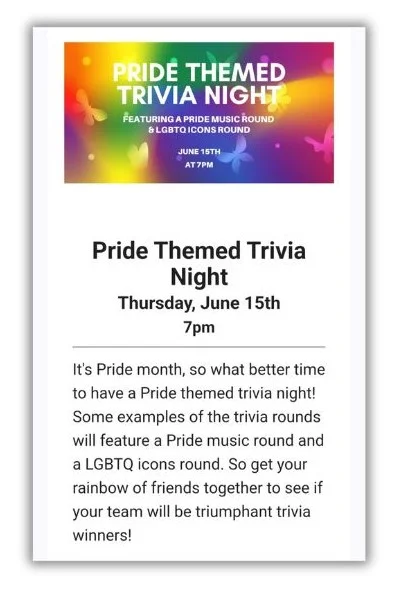

If you want to be an ally, find meaningful ways to lend your content platforms. These ideas will get you started:
- Make a watch list of LGBTQ movies, from comedies to documentaries.
- Host an event on Instagram Live, like a trivia contest or speaker series.
- Share stories of important LGBTQ figures that shaped the culture and movement.
- Organize a Pride parade watch party.
D-Day (June 6)
On D-Day, we remember the thousands of brave soldiers, sailors, airmen, and marines who participated in the Invasion of Normandy during World War II—the largest amphibious invasion in history.
Plumbers “R” Us does an excellent job of using its Instagram page to remind its followers of the aftermath of D-Day.


Here are a handful of ideas you can use to keep the memory of this day alive:
- Share images from the fateful day and a few brief words explaining what it means to you.
- Suggest a moment of silence at a particular time on June 6.
- Create a slideshow or Instagram Story highlighting a few inspirational figures from that day.
- Publish a blog post about World War II war memorials or museums in your area that people can visit.
More June awareness content ideas
June offers a lot to be thankful for and mindful of. These additional content ideas are a great way to share this with your followers and customers.
- National Adapt-a-Cat Month
- National Foster a Pet Month
- National Say Something Nice Day (June 1)
- International Corgi Day (June 4)
- National Hug Your Cat Day (June 4)
- International Yoga Day (June 21)
- National Take Your Dog to Work Day (June 21)
- National Yard Games Day (June 21)
- World Day of Music (June 21)
- Global Beatles Day (June 25)
- Alzheimer’s and Brain Awareness Month
- National Play Outside Day (June 1)
- National Go Barefoot Day (June 1)
- World Pet Memorial Day (June 11)
- National Random Acts of Light Day (June 13)
- US Army Birthday (June 14)
- World Blood Donor Day (June 14)
- Global Garbage Man Day (June 17)
- World Rainforest Day (June 22)
- World Refugee Day (June 30)
- National Day of Indigenous People (June 21)
- Family Owned & Operated Business Day (June 23)
- Helen Keller Day (June 27)
Summer fun June content ideas
Summer takes off in June, so there are plenty of sun-fueled topics to discuss online. Travel, beach days, pool parties, and outdoor activities are all on the table. These creative June content ideas will let you tap into those hot summer vibes.
Ask a summer-related question
Engagement is key to success in digital marketing. You don’t just want to talk at your audience; you want them to participate in the conversation. One surefire way to do it is to ask questions.
Here’s a simple option to start the conversation. Post a question in an image that people can answer in the comments.
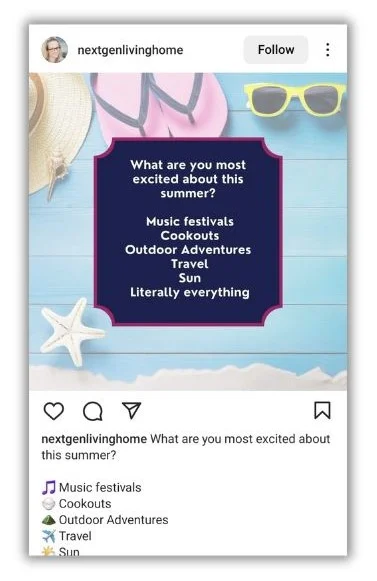

Polls on Instagram and other platforms can also work. You can even ask for feedback through email and ask if it’s okay to share it on other channels. The opportunities are endless, so consider this list of questions as inspiration for your next June campaign:
- Beach or mountains for the summer?
- Favorite summer food?
- Favorite beach?
- What song makes you think of summer?
- Best summer vacation?
- Favorite summer activity: fishing, outdoor concerts, grilling, hiking?
- Most recent summer read?
Gather summer-themed UGC
User-generated content is the not-so-secret weapon of the best online marketers. Why is it so great? Because it’s a fast way to fuel your online content from real people who use your product. It’s a triple win!
UGC is great for June content because people are excited to share their images of early summer. To boost your June UGC campaign, tie it to a free giveaway or contest, like Hydroflask did.
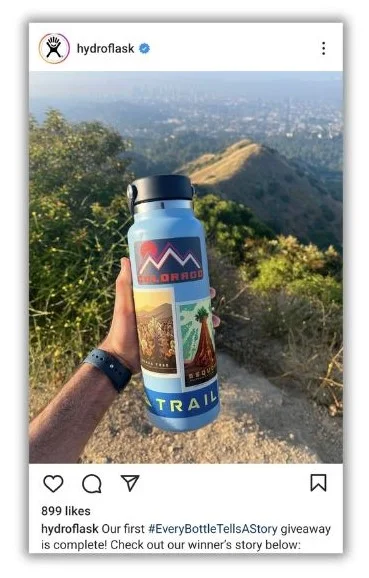

Ask your fans and followers to enter the contest by following your account, liking or commenting on the post, or clicking a link to a contest landing page. Notice how Hydroflask also used a unique hashtag. That’s a fantastic tactic to make it easy for people to share your campaign in their networks.
You can run a UGC campaign at any time, but here are a few days in June that would be ideal for it:
- National Selfie Day (June 21)
- National Camera Day (June 29)
- Social Media Day (June 30)
Create summer to-do lists
People start making summer plans as soon as the temperature starts climbing. It’s easy to feel like you’ve left something important off the list. Help your audience by creating a themed summer to-do list and distributing it as part of your June content calendar.
YouTuber Becca Bradley posted this summer bucket list on YouTube, which gave her followers many ideas for spending their summer days.
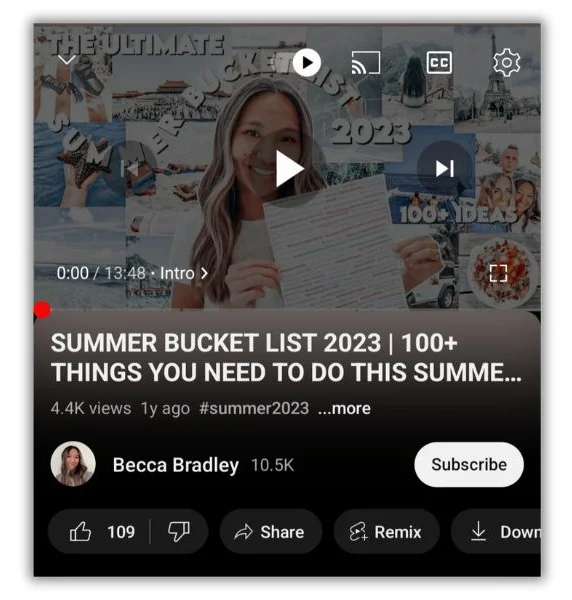

What’s great about this June content idea is that you don’t need expensive recording equipment or editing apps. Just make a list of summer activities and explain them. You can even add a theme, like activities with your pet or activities for kids.
Give your summer to-do lists a little more focus by tying them to fun observance days. Here are some ideas:
- Conservation efforts for National Pollinator’s Month, World Environment Day (June 5), or World Ocean Day (June 8)
- Kid-friendly activities for National Zoo and Aquarium Month, National Drive-In Movie Day (June 6), or World Picnic Day (June 18)
- Outdoor activities for Great Outdoors Month, National Parks Trail Day (June 1), or National Go Fishing Day (June 18)
- Summer sports to try for World Bicycle Day (June 3), World Softball Day (June 14), or National Tennis Week (June 23 to 29)
June content ideas to keep the summer vibes rolling
Your June content will be a valuable marketing tool whether you’re after awareness, looking for leads, or counting on conversions. The keys to success are to be authentic and creative so your audience has a reason to look forward to the next post, email, or video.
While you mull over the content that will fill your June calendar, get even more inspiration from these June marketing guides:
-

 MARKETING3 days ago
MARKETING3 days ago18 Events and Conferences for Black Entrepreneurs in 2024
-

 WORDPRESS6 days ago
WORDPRESS6 days agoBest WordPress Plugins of All Time: Updated List for 2024
-

 MARKETING5 days ago
MARKETING5 days agoAdvertising on Hulu: Ad Formats, Examples & Tips
-

 MARKETING6 days ago
MARKETING6 days agoUpdates to data build service for better developer experiences
-

 WORDPRESS6 days ago
WORDPRESS6 days agoShopify Could Be Undervalued Based On A Long-Term Horizon
-

 PPC6 days ago
PPC6 days agoLow Risk, High Reward YouTube Ads alexking
-

 WORDPRESS4 days ago
WORDPRESS4 days ago5 Must See Telegram Plugins for WooCommerce
-

 MARKETING4 days ago
MARKETING4 days agoIAB Podcast Upfront highlights rebounding audiences and increased innovation




